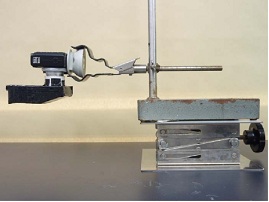Maximum quantity allowed is 999
Chemistry Chat
- Visit to a School Science Lab - Visit to a Science Club: Chemistry Club at Shibuya Kyoiku Gakuen Makuhari Junior and Senior High School
Introduction
On this occasion, we would like to turn a spotlight on the chemistry club at Shibuya Makuhari Junior and Senior High School, which has received multiple awards such as the Golden Award in the Chemistry Club Presentation 2011 hosted by the Chemical Society of Japan, Kanto Branch. We visited the club on July 30, 2013, just after the summer vacation had started. The school encourages the idea of "Self-thinking, Self-awareness" as an educational goal, and is very active in cross-cultural experiences to nurture internationally-minded individuals. At the laboratory where we were invited, the club members were preparing demonstration experiments for the school cultural festival in September. A student counseling room and teachers’ office are located nearby, and it could be seen that the school has been providing a quality education in chemistry, which is rich in personal attention.

Members of the chemistry club with TCI pens and notes in hand. Four teachers Mr. Toya (back row left), Mr. Murakami (middle row left), Mr. Iwata (middle row right), Ms. Sahara (front row right), and the captain Ryoichi Yabuki (front row center).
Chemistry Club at Shibuya Makuhari Junior and Senior High School


It is hard for junior and senior high school students to acquire college-level knowledge and experimental techniques, but it’s a lot of fun. We cannot do without teachers with specialized knowledge. Experimental techniques, however, have been passed down from students in upper-grades to students in lower-grades. I believe that experience in the chemistry club will be helpful in my future.
I am interested in fields relating to chemistry and biology so I am taking a biology class, too, at my school. I would like to go to a college where I can study pharmaceutical sciences.

Students are performing an experiment. A fume hood is in the back.

“Rikejo” are attracted to a TCI pen. “Rikejo” is a shortened form of Rikei Joshi in Japanese, which means women seeking to acquire expertise in science.
Award winning results (school grade at the time of award receipt.)
Academic year 2012:
10th Japan Science and Engineering Challenge (JSEC, hosted by the Asahi Shimbun, supported by multiple government agencies including the Cabinet Office)
A suspension membrane of calcium hydroxide is formed in a striped pattern when calcium metal reacts with water. In this study, the forming conditions and behavior of the membrane are examined from experimental results, and its fundamental rule is considered. It is also demonstrated that the viscosity of a solution and surface tension are influential in forming a liquid membrane.
30th Chemistry Club Presentation (hosted by Chemical Society of Japan, Kanto Branch)
This study examines the effect of anions contained in ionic substances by analyzing emission spectra of the flame light reaction when mixing various inorganic copper compounds and ionic substances. The self-made spectroscope described above and Makali`i for the spectrum analysis are used.
This study observes the effects of microwave irradiation on ionic crystal hydrates. A microwave oven (700W) is used for the experiment.
6th Science Research Presentation (hosted by Chiba University)
Metal dendrites, crystals with a tree-like branching structure, can be separated from a metal having a smaller ionization tendency by making use of the differences among metals. In this study, Ryoichi Yabuki focuses on copper and examines various conditions to promote the dendrite growth. The shape of a zinc plate is reported to be the most influential on the growth.
Polyaniline membrane, a conductive polymer, is produced by mixing ammonium peroxodisulfate and a saturated aniline aqueous solution. This study aims to investigate the forming conditions of a membrane and the connection between its electrical conductivity and color. Kai Shimomura has found that the electrical conductivity and color are changed by adding acids and bases when a membrane is formed, and also reports that addition of metal ions causes an increase in membrane intensity and alteration of electrical conductivity.
This study reports on the synthesis of esters with silica gel as an acid catalyst. This reaction proceeds efficiently even at 30 ºC.
Academic year 2011:
29th Chemistry Club Presentation (hosted by Chemical Society of Japan, Kanto Branch)
Best Poster Award (K. Teranishi, 10th grade, S. Nakamura, 8th grade): Origin of Life, Part VI
Best Poster Award (K. Shimomura, 10th grade): Effects of Amines on Aniline Oxidation
Best Poster Award (Y. Misawa, 8th grade): Preparation of a Fluorescent Material Glowing Three Colors
5th Science Research Presentation (hosted by Chiba University)
Second Prize (S. Nitta, 11th grade): Silver Mirror Reaction with Common Drinking Water